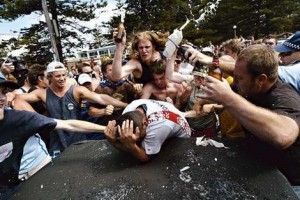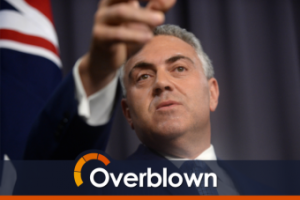Why do people riot?

As we look at the turmoil around the world, it only reinforces how lucky we are to live in Australia. While it is far from being a perfect society, we do not see people being slaughtered because of their religion or ethnicity. We do not have to fight to have fair elections or for the right to speak freely. All people have the opportunity to gain an education and our standard of living is one of the highest in the world.
But even in this halcyon environment we have seen moments of unrest as in the Cronulla and Redfern riots. They do not compare to the riots we see elsewhere, with troops killing their own people, but they were symptomatic of underlying tensions nevertheless.
The 2005 Cronulla riots grew from an incident where a verbal exchange had taken place after three lifesavers approached a group of four young Lebanese men on Cronulla Beach with both groups accusing the other of staring at them. One of the Lebanese men reportedly responded to the accusations, “I’m allowed to; now fck off and leave our beach”, to which a lifesaver responded, “I come down here out of my own spare time to save you dumb cnts from drowning; now piss off, you scum”. Testosterone took over and a fight ensued.
Racial tensions were already prevalent among the two racial groups due to the Sydney Gang Rapes of 2000, among other social incidents, which likely contributed to the scale of the escalation.
Several other violent assaults occurred over the next week, encouraged by idiots like Alan Jones who said “We don’t have Anglo-Saxon kids out there raping women in Western Sydney”.
Jones also broadcast and endorsed one listener’s suggestion that bikie gangs be brought down to Cronulla railway station to deal with “Lebanese thugs” and that the event be televised, arguing that despite their reputation bikie gangs do “a lot of good things”. By Thursday, Jones had stirred significant discussion, and stated “I’m the person that’s led this charge here. Nobody wanted to know about North Cronulla, now it’s gathered to this.” Jones was later found to have breached the Australian Communications and Media Authority (ACMA) Code of Conduct section 1.3(a), as his comments were “likely to encourage violence or brutality and to vilify people of Lebanese and Middle-Eastern backgrounds on the basis of ethnicity.”
The next weekend, approximately 5,000 people gathered in and around North Cronulla Beach and, in a shameful display of alcohol fuelled mob mentality, flag draped yobbos went around attacking innocent people just because they had a swarthy complexion.
When everything finally settled down, I think there was shame felt on both sides with apologies made by some of the worst perpetrators. Hopefully some lessons were learned, not least of all by Alan Jones.
The Redfern riots in 2004 were also sparked by a single incident – the death of T.J. Hickey, a 17-year-old Aboriginal youth who died after losing control of his bicycle during an alleged police chase. There were claims that the police car clipped T.J’s bike but the police deny this.
On the evening of 14 February, Aboriginal youths gathered from across Sydney to the Redfern area, and when police closed the Eveleigh Street entrance to the station, the crowd became violent and began to throw bottles, bricks, live fireworks and Molotov cocktails. The violence escalated into a full-scale riot around The Block, during which Redfern railway station was briefly alight, suffering superficial damage. The riot continued into the early morning, until police used fire brigade water hoses to disperse the crowd. Total damages include a torched car (previously stolen from a western suburb), and 40 police officers injured.
Writer-director Sarah Spillane produced the low-budget drama Around the Block, set amid the turmoil in the Aboriginal community during the Redfern riots.
A long-time Redfern resident who taught at the largely indigenous Eora College, Spillane said:
“The riots were a scary time for everyone, including the local indigenous residents, because tension between locals and the police had reached boiling point. There was a lot of anger and The Block looked and felt like a war zone.”
Spillane knew the personal stories of teenagers caught up in the riots. Like Liam in the film, many were torn between a sense of duty to fight for their community and wanting reconciliation through other methods. She saw students at Eora turning to art, music, video and theatre to get their voices heard.
It would be easy to label those involved in these incidents as hooligans or criminals but that would not be accurate.
It usually takes an incident to get a riot started, such as an accident or the police attacking or killing an innocent bystander. But once it has begun, the raging mob has a life of its own. Deep-seated resentments, repetitive frustrations and long-standing disappointments galvanize people into action. And the mob provides cover, an anonymity that makes it easier to overcome one’s usual reticence or moral scruples. One is immersed, engulfed. And it can become an exuberant experience, a joyful release for long suppressed emotions.
It offers a kind of intense belonging, not dissimilar to what spectators feel at a sports event or fans at a rock concert. But because it isn’t focused on a game or performance, it easily gets out of hand.
This is not to justify the behaviour of the mob, but to recognize that we all can so easily become “hooligans” ourselves. To be sure, delinquents and petty thieves can easily join in under the cover the mob provides. But riots do not rely on criminals or “criminality, pure and simple”, as David Cameron described the 2011 riots and subsequent looting in England.
Thinking that way, though, can distract us from the underlying conditions that give rise to such events. They can be appeals to be heard, when normal channels don’t work. They can be eruptions of rage, when frustrations boil over. They can be expressions of hope that things could change. And they could be all these things – and more.
And that is what the Australian people are feeling with this Abbott government. These very feelings caused the recent riots on Manus Island.
Not that I am suggesting there will be rioting in the streets – violence never solves anything – but, as they said in Newsweek after the English riots:
“If there’s one underlying condition that these movements share, it has to do with unemployment and bitter poverty among people who desire to be part of the middle class, and who are keenly aware of the sharp inequality between themselves and their country’s wealthy elite.”
Take heed Mr Abbott before you send this country down the path of entrenched poverty.
Note: Changes to Newstart expected to save government $1.2 billion. Foregone revenue from giving tax concessions to people fraudulently claiming business usage of their vehicle – $1.8 billion.
Also by Kaye Lee:
Hi ho, Hi ho….where am I spose to go?
It’s all about the choices you make
My kids are ok, yours can go beg
Like what we do at The AIMN?
You’ll like it even more knowing that your donation will help us to keep up the good fight.
Chuck in a few bucks and see just how far it goes!
Your contribution to help with the running costs of this site will be gratefully accepted.
You can donate through PayPal or credit card via the button below, or donate via bank transfer: BSB: 062500; A/c no: 10495969










